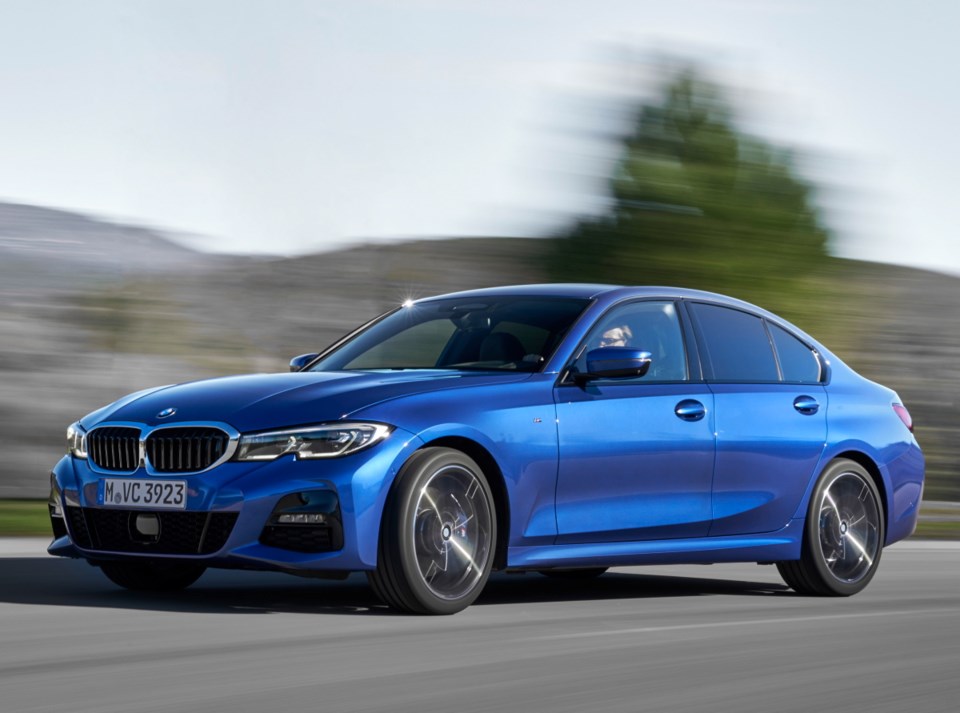The 3-series sedan established BMW as a major player on the global vehicle scene. In March, the seventh-generation version hit the streets.
Numerous entry-luxury competitors from Audi, Mercedes-Benz, Jaguar and Lexus continue to challenge the 3’s dominance, but for reasons mostly related to overall performance and brand cachet, the Bimmer continues to be popular.
The new 3-series continues its conservative evolution, making it difficult to discern new from old. The front profile has been smoothed out and slightly lowered, while the underbody has been almost completely sealed off to reduce drag (to improve fuel economy).
The kidney-shaped grille and lower air intakes have been enlarged and LED headlights are standard. The total glass area has been increased, thinner windshield pillars improve visibility and help reduce wind noise, and the hockey-stick-shaped taillights are more expressive.
The aluminum hood and front fenders contribute to an overall weight reduction of up to 55 kilograms, depending on the model, even though the 3-series is nearly eight centimetres longer and about 1.5 centimetres wider and taller than before. The distance between the front and rear wheels has grown by about four centimetres and trunk space has increased by about eight per cent.
The resulting roomier interior provides more front shoulder room and more rear legroom. The modernized dashboard has a 22-centimetre touchscreen and a 14.5-centimetre display in the gauge cluster. For the optional Live Cockpit, the touchscreen is 25.5 centimetres and the all-digital gauge package/display is 31 centimetres.
BMW points out that the 3-series’ new platform is considerably stiffer and gets all-new front and rear suspensions. Included are continuously variable dampers to improve ride and stability when cornering.
At launch, only two xDrive all-wheel-drive sedans will be available. The 330i runs with a 255-horsepower turbocharged 2.0-litre four-cylinder (up seven horsepower from the 2018 engine). Torque is the big story, here: It has been increased by 37 pound-feet to 295. Combined city/highway fuel economy is estimated at 9.1 l/100 km.
The late-arriving M340i xDrive uses a turbocharged 3.0-litre inline six-cylinder engine that produces 382 horsepower and 369 pound-feet of torque.
A new 330e plug-in hybrid model is also in the works for the 2020 model year.
The xDrive all-wheel-drive system maintains a rear-wheel bias in most driving situations, and will send all of the torque to the rear wheels in light-load conditions, such as on flat roads.
The sole transmission, regardless of engine, is an eight-speed automatic with optional paddle shifters. This marks the first time that a manual gearbox won’t be available in the 3-series.
The base 330i xDrive rings in at $51,850, which includes tri-zone climate control, 10-speaker audio system, rain-sensing wipers and emergency braking that can avoid pedestrians and cyclists. You’ll pay extra for the Driving Assist package that comes with lane-departure warning, blind-spot detection with cross-traffic backup alert and active cruise control, which maintains a safe distance while following other vehicles.
The range of price-inflating options includes premium interior trim, head-up projection display, adaptive Laserlight headlights, M Sport suspension and M Sport differential, which sends added torque to the outside rear wheel when cornering. BMW’s Personal Assistant allows control of various systems by voice command, such as heat, audio and navigation.
Ultimately, customer preferences are leaning heavily toward utility vehicles. No matter how good the new 3-series is, the main competition might not be from other automakers such as Audi, Acura and Mercedes-Benz, but other BMW vehicles, such as the X1 and X3.



